Zenith’s headline read: “All-electric Zenith ‘Sky Jeep’ completes first flight, with plans to transport doctors and medical supplies in remote areas of the world.” Several aviation publishers jumped on the news* from light kit-built market leader, Zenith Aircraft.
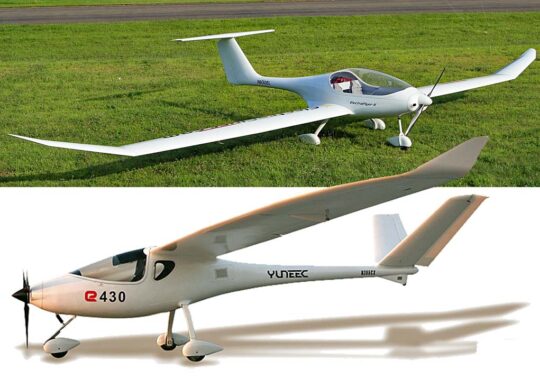
TOP: Electric pioneer Randall Fishman evolved Song into ULS after he adapted electric power (article). BOTTOM — Yuneec e430; it never made it to market.
I’m curious what you think of (1) electric propulsion on any aircraft and (2) electric power for an aircraft used, let’s say, for exploring. If you have an opinion and care to share it, use the comment feature.
To date, most electric-propulsion entries have been sleeker designs. Pipistrel has been a leader in this class; they got their start building sailplanes and motorgliders and never lost their preference for clean, smooth shapes. Many others also participated (nearby images).
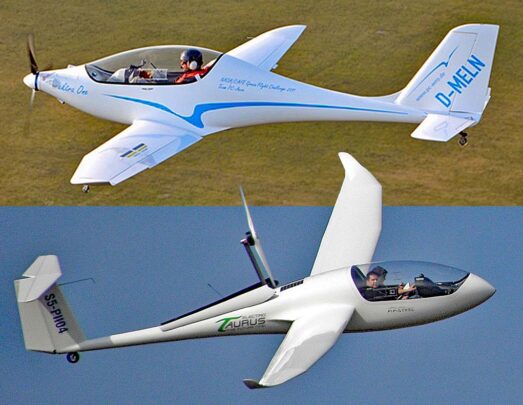
TOP: Electra One, which first flew almost ten years ago. BOTTOM: One of Pipistrel’s earliest electric projects was converting their Taurus motorglider to the tiny motor seen in the image; this is a sensible use of this power source because it is only needed for launching and initial climbout.
Bye Aerospace’s eFlyer continues its long path toward the market. This development company based its aircraft on Arion’s Lightning airframe, a smart choice as Lightning is so smoothly constructed. This article describes what was then called Sun Flyer.
It makes sense doesn’t it? A slippery fuselage will demand less of the batteries. This probably has a lot to do with why we never heard more about an electric Cessna 172. That project probably died when the combination didn’t prove very efficient.
So, Why Electrify a CH-750?
The short answer is… not everyone wants to fly a distance at high speed. Distance is already a challenge for battery-powered aircraft and to fly fast either takes more power or the airframe better be very low drag.
But what if you only need to cover a shorter distance, perhaps one only served by switchback roads through mountainous terrain? What if getting fuel to remote locations is difficult or impossible. How can someone more swiftly serve such hard-to-reach places?
A British project has the goal of delivering healthcare in remote parts of the world. Their all-electric Zenith CH-750 Cruzer took its maiden flight on January 20, 2023. Their aim is to provide a low-cost, rugged, and practical aircraft for use in rural and hard to reach communities, such as medics in Uganda and doctors in rural India.
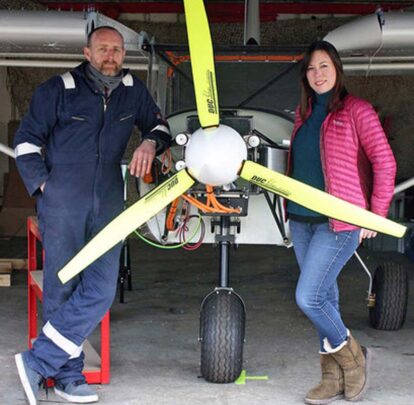
The Bridges are propelled by their backgrounds and deep environmental concerns. Tim has extensive experience in renewable electric energy projects. He said, “Earning a degree in meteorology and oceanography brought into stark focus the impact we humans have had on our planet.”
Helen said she is “a Corporate Social Responsibility Manager for a global financial services organization,” and “a Trustee for an international children’s charity, supporting young people displaced by poverty, violence and abuse across the world.” Strong in her beliefs, she closes with “…don’t get me started on the climate crisis.”

Given its STOL (short takeoff and landing) capabilities, the manufacturer said, “Zenith’s CH-750 is well suited for ‘off-airport’ operations, and can be flown in and out of shorter runways that may also be ‘unimproved,’ such as grass or dirt landing fields.”
The Bridges founded their company, NUNCATS, in 2019. Now that the aircraft has been completed and flown they predicted, “As soon as funding allows, we hope to move towards getting this into communities where it can make a real difference. There are currently a billion people in the world with no access to healthcare.” The project is still seeking backers and sponsors to help fund its development.
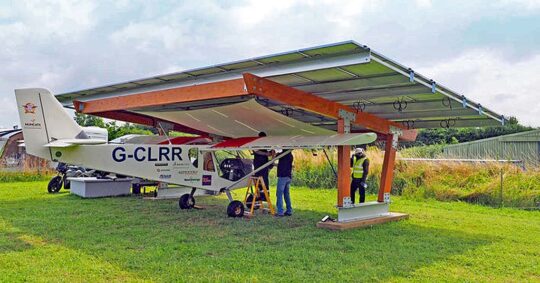
While this solar charging array and “hangar” needs to be transported to a remote location and set up, at least this only needs to be done once. Gasoline would have to be transported regularly.
How about your interest? The Bridges note, “The ‘electric sky jeep’ kits can also be purchased as a greener option for sports flyers.” When FAA releases Mosaic, it will permit electric and hybrid propulsion, so other entries are likely to follow.
The Bridges partnered with Zenith and several start-up investors to acquire an existing design and adapt it for all-electric operation. Like the hundreds of other electric projects, all await better batteries.
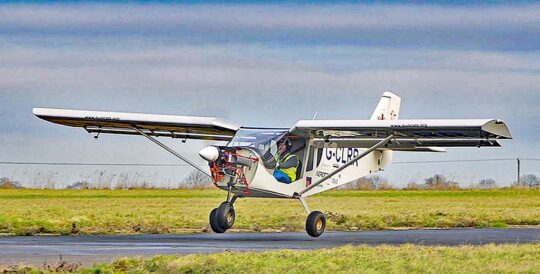
Nuncats’ e750 makes its first flight in late January 2023.
“While we all know that today’s battery technology will not permit the range and endurance available with ICE [internal combustion engines],” said Sebastien Heintz, president of Zenith, “there are some clear advantages of electric power in addition to the more obvious sustainability claims.” He added, “The simplicity of electric motors has the potential to make light aircraft propulsion systems more reliable and easier to install and maintain. This is especially important for amateur aircraft builders and owners. The near-instantly available torque of electric power can further improve upon the STOL performance of our kit aircraft designs.”
Sebastien recognizes that by combining these technologies — airframe design, electric propulsion, and ground-based solar charge stations — people like the Bridges may address real needs around the world in ways that have not been possible before. “We’re thrilled to see the proven Zenith designs being used for this, and anticipate that amateur kit builders will soon be able to access this technology for their light aircraft projects, here and around the world.”
Does electric propulsion excite you? Would you like to move this direction, either in the sort of aircraft you fly today (perhaps a Zenith CH-750) or a multicopter style? Let me know in the comments below.
ARTICLE LINKS:
- Zenith Aircraft, link to contact info and all article and video on this website
- Zenith Aircraft, company website
- Zenith Aircraft CH-750, company info on this model
- Nuncats, company website
- Link to many articles on electric propulsion on light aircraft
* I commend aviation outlets who quickly published this story. I’m always pleased when general aviation publications pick up on LSA or Sport Pilot kit news. I wanted to take a day to put this electric Sky Jeep in context with other electric aircraft.


First, there is a place for electric powered aircraft…..a very very tiny small place. A temporary place, where nothing else will work. Everything else that flies still needs fuel (oil) and will for a long time. What most people here don’t understand (including the “experts”) is, It takes oil, (a huge amount), to build the solar and wind systems, to transport them, to assemble them, to maintain them, to recycle them and inevitably to replace them when they fail. Yes, even more oil than they will ever “save”; it takes oil to move the people around that are doing all this work; It takes oil to mine the materials, to build the factories, to refine the minerals, to build the batteries, to produce the copper wire, to get all of this from where it was found to where it needs to go. Before you generate the first watt of electric power, it takes tons of oil. If you are not a manufacturing engineer like me, just take my word for it. Oil works day or night, sunny or cloudy, in freezing or hot weather, in heavy or high drag vehicles, Whenever you need it, and is dense enough to store in required quantities. When and if Fusion become reality , and when the those systems are finally built, (again, using oil to do it), then and only then will we have anything resembling something Greener or cleaner than “hydrocarbon power”.
Having said all that, My electric ultralight will be used to get past the noise that my neighbors would surely object to, allowing me to fly off my property, even though I still can not fly anywhere that I couldn’t easily walk to. I can plug my craft into my solar panels and charge the batteries, with my system that has already used untold amounts of oil to manufacture ,transport and assemble. It is not a practical thing; and you should also know, in reality, it is NOT a “green thing”. The only utility is in the novelty and fun-factor.
There is one minor inaccuracy in what you’ve written. In place of your use of “oil”, read “energy”. That is, it requires energy to make more of it, and our economy for the past century and more has used petroleum products as the source of energy. Before that we used wood and coal, and very little oil. And we will continue to need the use of oil ans other petrochemical products to supply the energy needed to bootstrap another shift to other energy sources and storage media. These may consist of hydrogen in various forms such as gas, liquid, and paste, chemical devices that serve as batteries, nuclear devices that create heat for steam or ions for direct electrical energy, solar converters of light and heat, and mechanical motion converters for winds and waves, and possibly some other means. At some point the technology will no longer depend on oil or other petrochemical sources, and these chemicals will be used for other purposes rather than as an energy source. But that technology is in its infancy, and hardly at all convenient or ready to replace heritage systems. We need to stop protesting over the drawbacks of any of these systems, and take all possible steps to use the energy we have already to develop new ones that are just as capable and convenient, and even more so. That will require a period of trial and error, and people who are willing to experiment and suffer the corresponding inconveniences. The first air vehicles were inelegant, and have been much improved during the past century. Much the same can be said of automobiles. Why should we expect anything different for our energy systems?
Being an electrical engineer who has worked on and used electric vehicles, I know the advantages and disadvantages to them. I own a battery powered walk behind lawn mower (21″ deck) and a battery powered weed trimmer. I truly like them both. Keep in mind that I also have a gas powered riding lawn mower (42″) deck. I have about a 1 acre lawn. It takes me about 90 minutes to use the gas powered riding lawn mower to bag all the grass clippings. I have used the battery powered walk behind lawn mower to do the same. It took me over 4.5 hours to do the job. If you did your math, it should have only taken 180 minutes based on deck size. During that time I swapped batteries several times. It was only due to having multiple batteries and multiple chargers that I felt comfortable doing this. The energy density of gasoline is far greater than the current batteries.
We need to have an honest understanding of the technology and APPLICATION! I totally agree with battery power walk behind lawn mowers. I don’t have to pull the cord and rip my arm out of its socket! However, does that mean I want a battery powered snow blower? NO! I know batteries are impacted by temperature, meaning I don’t want to run into the house every few paths to swap batteries. The power source has to match the application! Using solar to charge the batteries of an airplane [gives me] concerns. What happens if there is an emergency and the charge on the airplane is only 75%. Will you go up or wait until it is fully charged? What about cloudy days? Just because there is another power source available doesn’t mean it will work on ALL applications. I have no problem getting a battery powered electric vehicle/tool if the manufacturer is HONEST about the runtime in service conditions and the infrastructure supports it. Why does the electric car lose range going across the country when using high speed chargers? The batteries are being over heated, which reduces their life. The run time of a battery powered snow blower should include heavy wet snow which is piled up at the end of the driveway from the plow and NOT dry fluffy snow which a leaf blower could blow away.
The technology will help in providing other sources but we shouldn’t use policies to demand it on applications that don’t make sense. It just shows how little one knows about the technology and the application.
Does this make sense?
I think you make an enormous amount of sense. Well done.
I see battery-powered aircraft as interesting in (literally) ultralight aircraft but these are novelties… very fun perhaps, but novelties nonetheless. Until batteries or other stored energy becomes vastly more energy dense, such propulsion is hardly “practical.”
Many of the commenters here don’t understand the need for basic electric development in remote parts of the globe, no roads on impossible mountain terrain. Sickness or injuries can spell slow death.
I have been in areas where it’s impossible to transport in fuel for anything let alone an airplane.
That leaves solar as the only option. Solar charging in each village. With one hour endurance, one can hop from one village to next to get to modern facilities. Light aviation need not be for the jollies of those who can afford it.
IMO, it deserves a little support and less knocking.
I love my Chevy Volt. It is the perfect electric car. In fact, it is the perfect car for now. It is not a Hybrid per se. I get a total of 462 miles. 60 by battery the rest with the range extender (fuel efficient 4 cylinder “generator). It provides the same energy per unit as the LiOn battery system. WHY? Simple to eliminate going to the gas station for most use. Smallish 60 mile on battery, charges up quickly on the very limited 110 volt 15 amp USA home power.
Why can’t this type system be in a plane? Do serious thinking before handoff rejection.
No battery miracle is going to give a car or a plane the mileage of a gas system.
Ed
Super article Dan!
Takes me back several years when I was covering the then-new LSA scene with you and had the distinct and memorable pleasure of flying three different electric aircraft for the magazines.
We’re still hoping for increased energy density batteries. I was hoping we’d have them by now. But they’re coming. And they will change everything.
As a happy Nissan Leaf EV owner here in the country, I can say unequivocally that all these arguments against electric vehicles are shortsighted and doomed to fade away, just as the bias against gasoline engines that “will never replace the horse!” did.
Major revolutions of change always face stiff resistance, until everybody “gets it.”
The use of a solar charging station like the folks in your story use is brilliant and practical. And just one way the change is going to happen. Solid-state, non-lithium, cheap batteries with far greater range-to-weight ratios and sustainable energy power grids will help banish the argument that electric energy suppliers today simply transfer the pollution problem.
It’s a huge change, it will take more time, and we humans do resist change until that ah-ha! moment, but electric transportation is coming, on the ground, on the sea, and in the air. And we need it, along with global changes in sustainable agriculture and a whole lot of other things. Yes, for climate change, and for the quality of life and the health and survivability of our species.
The smooth, quiet, exhilarating experience of electric flight is transformational: hard to describe but so indelible the moment you surge off the ground and feel that big grin spread across your face.
Truthfully, I am so disappointed in the push for electric everything. The technology is just not there yet. The infrastructure isn’t even close. It is not green not even a little bit. For every action there’s an equal and opposite reaction.
I agree we should get the lead out of low lead. Airplanes should catch up with the automotive industry as far as fuel economy is concerned. That’s doable and it’s doable now. Put these pipedreams back in the pipe where they belong.
On another completely different topic I’m surprised that you Dan have never done an in-depth report on the Vashon Ranger. Let’s face it. Most people are old geezers like we are. We have the money to buy planes and we want to fly now. The Ranger is safe, economical, anybody can work on it, and the company is owned by a rich guy so going out of business in the middle of the night is probably not gonna be a concern. Your thoughts would be appreciated.
Perhaps it didn’t have all the detail you wanted, but I did do this review of Vashon Ranger.
I’ll stick to my gas airplane and will never buy electric whether it be a car or aircraft.
Just another piece of our critical infrastructure, like pharmaceuticals, rare earth elements, and many others that the U.S. is dependent on the CCP for. Until someone can show me how we can support the EV technology from home, I am against it.
And don’t even get me started on “Climate Change”
You nailed it! It’s a smoke screen for swamp culture. When we listen to the science, from the people that have studied this for their entire lives, we get the truth. Politicians will lie about what they ate for breakfast. They are power-hungry, philandering, bottom-of-their-class idiots that cannot get a job anywhere else. But, they have bad qualities, too.
Electric aviation is the wave of the future, and will remain so for the next 20 years. We are at the development phase equivalent to the 1886 Benz Patent Motor Car. It was certainly the first car but was exceedingly expensive and deeply limited in its capabilities. When battery and electric motor technology improve logarithmically then we will see something akin to Model T of the air.
You’re shifting the energy from the ICE to the power plants. Depending on what fuel your power plant is using it could be dirtier than an ICE. You still need to provide a certain amount of energy to move a given weight/drag through the air no matter the energy source used. Sure they are neat and quiet, I just wish folks would use new technology for what it is and quit hyping how green it is. Still has a way to go to be really viable. Don’t forget that just about every part in an electric vehicle needs oil to produce them in some shape or form.
Did you not notice they plan to use solar power stations? These places are so remote there is no power plant on the grid burning fossil fuels.
Many of the commenters here don’t see that.
I have been in areas where it’s impossible to transport in fuel for anything let alone an airplane.
That leaves solar as the only option.
Yes I did and that would be one solution. But until there’s one of those in every place there’s a fuel pump you will be limited to where they are. Severely restricts your ability to go where you want to.
To expand on my fossil fuel comment. The molecules needed to produce the various components need for these electric vehicles are basically byproducts of oil refining. So without fossil fuel consumption or adequate fossil fuel consumption you won’t have these molecules for your electric vehicles. There’s no way the refineries will pull the oil out of the ground, refine it, separate the needed molecules and then return what’s not used back to it source. It’s called integrated oil for a reason. And then there’s all the chemicals for medicines and a host of other products that come from them.
I see electrics as a viable companion to fossil fuels, I just don’t see them taking their place anytime in the near future.
I just don’t trust the EV. I’ve seen too many catch fire, too expensive tho buy), and to replace the battery is very expensive.
Just because you’ve seen one or another electrical appliance malfunction, is no justification to distrust all appliances. Each and every design is different, and aircraft are required to pass more stringent testing before they can be certified. Maybe you should avoid trying to equate apples and oranges.
Toasters don’t kill people; they tripped circuit breakers. Talk about apples to oranges.
Yep…I totally agree with you Rick. The electrical infrastructure (re-charging) and the environment is not ready for mass production of EV’s. The pollution with electrical is the same….except that the production of pollution occurs before and after consumer use (mining, lack of re-cycling, disposal of batteries, etc.), so the owner/driver of the EV (wrongly) believes that he/she is being environmentally friendly. Last year, California in particular, consumers were asked to cut back on electrical consumption, so the grid won’t be overloaded, and that’s with EV not being in every garage yet !
I’m fully in favor of electric propulsion, particularly its enabling of vertical and point-to-point operation. But numerous technical challenges remain to be solved — not the least of which is stored energy methods and densities. We have already begun to see how it affects vehicle designs. Meanwhile, existing traditional designs may be adapted to employ it, but still have to overcome the energy storage challenges.
It doesn’t really matter what “old school” pilots say. It’s what the kids want. And they don’t want combustion engines.
In the meantime, the driver in this is economics. Like wind turbines in
Texas, they’re more cost effective than burning oil. Flight schools know this.
The future is here. Accept it or be left at the station.
Texas wind turbines have shown themselves terribly ineffective as they succumb to freezing weather and leave electricity consumers to freeze likewise. But you’re right that economics will determine the use of electric propulsion for aircraft. It ultimately favors only those technologies that actually work, rather than mere fads “that the kids want.”
Game Changer?
Who will be first to cover their wings with lightweight solar cell “fabric”?
https://youtu.be/j4e-HrK27VA
Lots of unanswered questions about solar fabric films. Cutting odd shapes to fit vehicular surfaces requires what means of electrical connections between them. How durable and how long-lasting their functionality and efficiency? Toxicity or recyclability of materials when trashed? And the most fundamental problem is that the amount of energy falling onto aircraft surfaces is less than the vehicle requires to operate, even during brightest day and even if one can capture it all. So at best it might extend the time provided by batteries which are essential for night-time and low-light operations.
I’m against electric vehicles of any kind.
You didn’t say why.
Ricky, I agree with you again. Let’s bypass electrical and go straight to nuclear fission*. I have it all figured out, but I’m waiting for the price of 2x4s to go down before I build a prototype**. Dave
* serious
** attempt at humor
While I can appreciate your attempt at humor, David, even nuclear energy will have to drive some motor mechanism. While mechanical steam turbines are possible, and quite traditional, electric motors are more likely for all sorts of engineering reasons. So electrical technology wouldn’t be bypassed, only the dependence on battery storage.